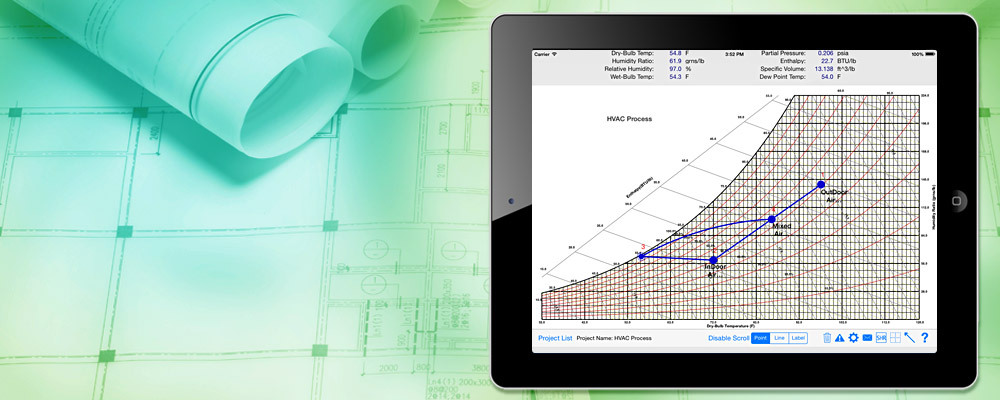Overview
I recently hosted an ASHRAE-sponsored webinar that discussed the basics of psychrometrics and also included a demo of the ASHRAE Psychrometric Chart iPad app (which we designed). I was amazed that almost 900 people registered for this webinar. This tells me that there is keen interest in understanding psychrometrics and also finding ways to more easily perform psychrometric calculations.
The following are links to both the webinar recording and a PDF of the PowerPoint slide deck:
- Click here to view a recording of the webinar.
- Click here to download a PDF of the PowerPoint slide deck.
This webinar included an overview of the science behind psychrometrics. Then, I demo’d the app by creating sample HVAC processes. This webinar could have easily gone on for two hours, but I was limited to one. I will split this topic into 2 separate blog postings. This month’s posting will talk about the basics of psychrometrics. A follow-up blog posting will show 10 example HVAC processes using the psych chart app.
Importance of Psychrometrics
The study and understanding of psychrometrics is so important for helping engineers to design HVAC systems for all types of applications and situations including:
- It’s vital for human comfort since it’s difficult to work when the conditions are too humid or too dry. The following slide displays the comfort zone for humans:
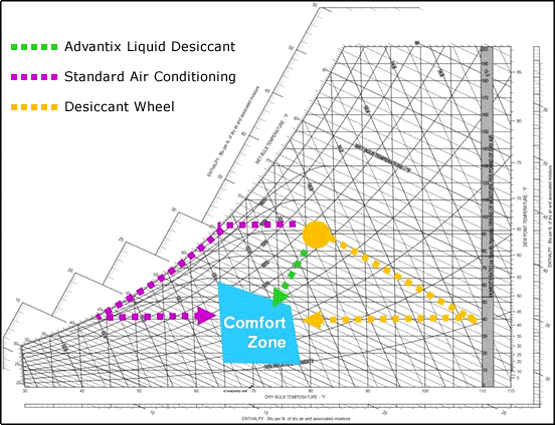
2. HVAC systems designed for controlling the environment (temperature, humidity and pollutants) within a museum, a library, or any type of archival facility is much more complex than the system designed simply for maintaining human comfort. This system is designed to control the environment for the preservation of highly valuable artifacts or works of art. These HVAC systems must be operational 24/7 and often require redundancy.
3. Hospital ORs are kept so cold that there is always risk of condensation from the ceiling since the temperature often goes below the dew point of ambient conditions (it’s called “raining in the OR”). Therefore, using psychrometrics, it’s possible to determine the proper humidity ratio of the air so as to eliminate condensation.
4. Many industrial and manufacturing companies use chilled water to remove heat from various manufacturing processes. As the air or process is cooled below the ambient dew point, condensation can occur. Desiccant dehumidifiers can eliminate this condensation. This results in a higher quality part and reduced cycle time, allowing manufactured parts to be produced faster.
Is it Art or is it Science?
If you take the equations from the ASHRAE Handbook of Fundamentals seen below and create a visual representation of those equations, it becomes a powerful tool for HVAC design.
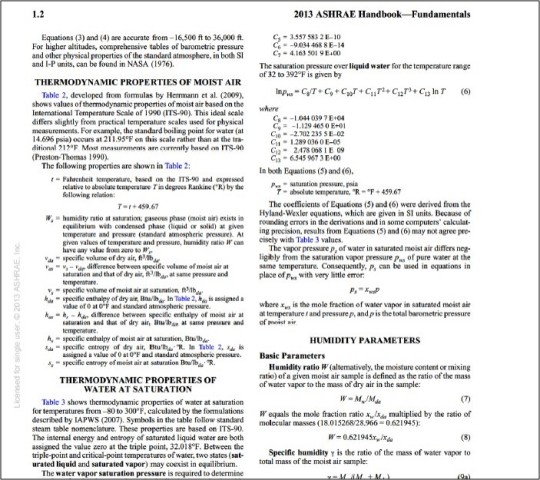
You create this visually appealing chart that allows you to plot simple and complex HVAC processes and actually visualize
them. Even those outside the industry can begin to understand what the ratios of air to water mean and how HVAC systems alter those ratios for the benefit of human comfort.
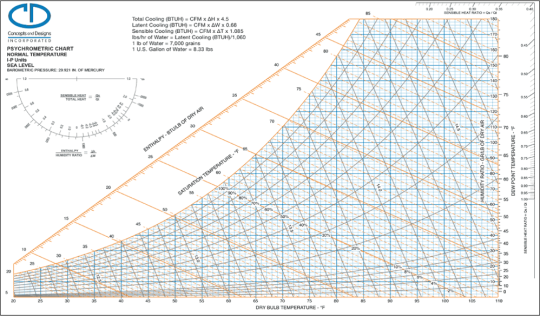
Definition of Psychrometrics
A psychrometric chart is a graph of the thermodynamic parameters of moist air at a constant elevation or barometric pressure. The genius behind this chart is that it allows HVAC professionals to visualize all types of HVAC processes for cooling, heating, humidification, dehumidification and much more.
Here’s a chart at 0 feet elevation:

Here’s a chart at 12,000 feet elevation. It looks a bit different than the 0 elevation chart:

Before psychrometric software for desktop or mobile, most engineers had to resort to using the 0 elevation chart even if they were designing a building in, say, Denver which is 5000 ft elevation. This produces inaccurate results because the density of air is so different between 0 and 5000 feet. As you can see, the elevation change drastically changes the shape of the graph.
The Components of the Psychrometric Chart
The following is a list of the components that make up a psychrometric chart:
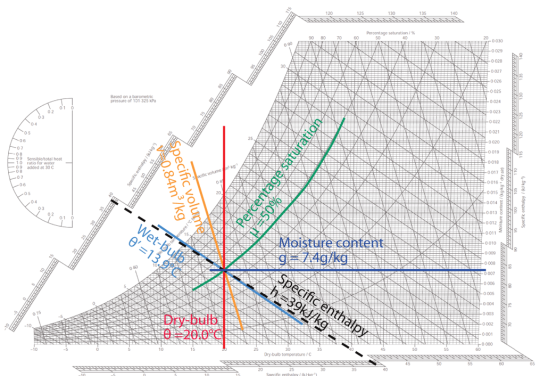
Dry bulb temperature: The temperature of air as registered by an ordinary thermometer
Absolute humidity or moisture content: The weight of water vapor in grains or pounds of moisture per pound of dry air or grams of water vapor per kg of air, i.e. g/kg. It is also known as moisture content or humidity ratio.
Wet bulb temperature: The temperature registered by a thermometer whose bulb is covered by a wetted wick and exposed to a current of rapidly moving air (sling psychrometer)
Enthalpy: A thermal property indicating the quantity of heat in the air above an arbitrary datum, in Btu per pound of dry air. The datum for dry air is 0 deg F and, for the moisture content 32 deg F water.
Specific volume: The cubic feet of the mixture per pound of dry air or cubic meter of the mixture per kg of dry air represented in m3/kg. It is the reciprocal of density. (1 over the density)
Relative humidity: RH is an expression of the moisture content of a given atmosphere as a percentage of the saturation humidity at the same temperature. Most everyone uses this # to communicate how humid it is out: 50% humidity.
Dew point temperature: The temperature at which condensation of moisture begins when the air is cooled. The best example of this is a cold glass of water. If the temp. of the water is less than the dewpoint of the ambient conditions, then you will see condensation on the outside of the glass.
SHR protractor: Allows the user to draw the SHR line which is discussed later.
Other Psychrometric Terms
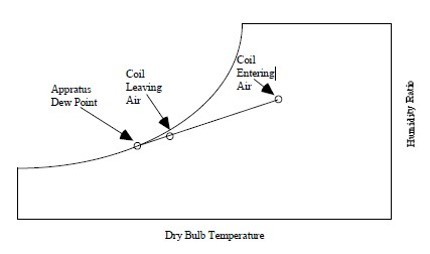
Saturation curve: This is where the air is 100% saturated no matter what the DB and WB temperatures are. Along this curve, the DB, WB, and DP are all the same at any 1 point.
ADP: Apparatus dew point (ADP) is the coil surface dew point temperature required to accomplish a cooling/dehumidifying process. As you can see from this simple psych drawing, the air entering the coil is cooled to slightly less than 100% saturation. If you want to extract water out of the air (dehumidify), then you need to approach the ADP which does
exactly that.
Bypass factor: Some of the air flowing through the coil impinges on the water tubes or the fins and is cooled to the ADP. Other air passes through unchanged.
SHR: The ratio of space sensible cooling to total cooling is useful for plotting the slope of the path that supply air travels after
introduction into the space.
Adiabatic cooling: This is also called evaporative cooling or constant-enthalpy cooling. Adiabatic cooling is the process of reducing heat through a change in air pressure caused by volume expansion. It’s also called free cooling since the sensible heat is being converted to latent heat without the help of mechanical DX cooling.
Simple Psychrometric Processes

Sensible heating/cooling involves the increase or decrease in the temperature of air without changing its humidity ratio. Example: passing moist air over a room space heater.
Humidification/dehumidification involves the increase or decrease in the humidity ratio of air without changing its dry bulb temperature.
Heating and humidifying involves the simultaneous increase in both the dry bulb temperature and humidity ratio of the air.
Cooling and dehumidifying involves the removal of water from the air as the air temperature falls below the dew-point temperature.
Evaporative cooling involves the cooling of air without heat loss or gain. Sensible heat lost by the air is converted to latent heat in the added water vapor. Also called “Free cooling”.
Chemical dehumidification or adiabatic dehumidification is accomplished by passing air through a chemical absorbent like silica gel. Some of the moisture is removed and the latent heat of evaporation is released. There will be an increase in sensible heat
content and along the enthalpy line.
Complex Processes

Complex psychrometric process include a combination of the simple processes discussed above. I will touch upon these complex processes in next month’s blog that will include up to 10 examples of complex psychrometric processes.
Click the following image to download the app:

Stay tuned for next month where I will describe 10 psychrometric use cases ranging from simple cooling to complex combo indirect/direct dehumidification and cooling.

